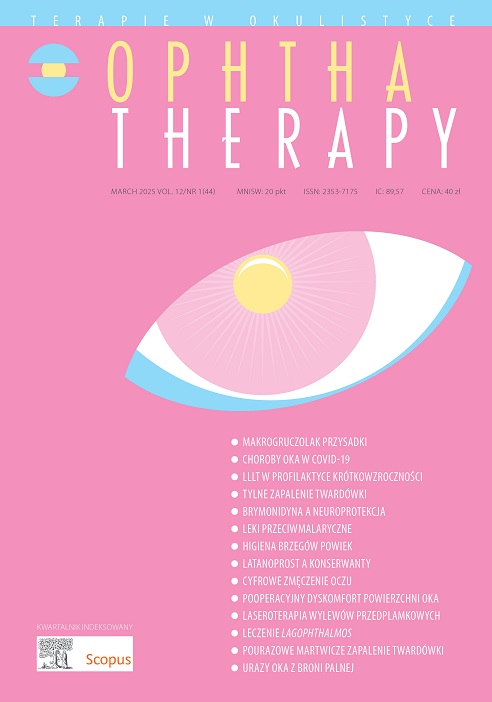Management of Trauma-Induced Anterior Necrotizing Scleritis in a High-Risk Occupational Setting: Resolution with Temporary Tarsorrhaphy Opis przypadku
##plugins.themes.bootstrap3.article.main##
Abstrakt
Objective: This case report highlights the challenges and innovative treatment approaches for managing trauma-induced anterior necrotizing scleritis (ANS), particularly in high-risk occupational settings, such as welding.
Methods: We present the case of a 44-year-old male welder who suffered a metal particle injury in his right eye, leading to ANS. Initial treatments included removal of the foreign body, suturing of the conjunctival tear, and administration of antibiotics and hydrating eye drops. Subsequent treatments for the ensuing ANS included systemic and topical steroids, cyclosporine drops, oral prednisone, vitamin C supplements, dura and amniotic membrane grafting, and autologous serum eye drops. Following the failure of these interventions, a temporary tarsorrhaphy surgery was performed.
Results: Despite the application of various conventional therapies, the patient’s condition did not improve significantly until temporary tarsorrhaphy was performed. This intervention, along with an intensive therapeutic regimen, led to the complete healing of the sclera and improved visual acuity.
Conclusion: This case underscores the complexity of treating ANS, especially in cases resistant to standard treatment modalities. The successful use of temporary tarsorrhaphy in conjunction with other treatments highlights the need for an individualized approach to manage such conditions. This case contributes to the growing body of evidence suggesting the potential benefits of revisiting traditional surgical interventions for treating refractory cases of ANS.
Pobrania
##plugins.themes.bootstrap3.article.details##

Utwór dostępny jest na licencji Creative Commons Uznanie autorstwa – Użycie niekomercyjne – Bez utworów zależnych 4.0 Międzynarodowe.
Copyright: © Medical Education sp. z o.o. License allowing third parties to copy and redistribute the material in any medium or format and to remix, transform, and build upon the material, provided the original work is properly cited and states its license.
Address reprint requests to: Medical Education, Marcin Kuźma (marcin.kuzma@mededu.pl)
Bibliografia
2. Lombardi DA, Pannala R, Sorock GS et al. Welding related occupational eye injuries: A narrative analysis. Injury Prevention. 2005; 11: 174-9.
3. Fiebai B, Awoyesuku EA. Ocular injuries among industrial welders in Port Harcourt, Nigeria. Clinical Ophthalmology. 2011; 5(1): 1261-3.
4. Reesal MR, Dufresne RM, Suggett D et al. Welder eye injuries. J Occup Med. 1989; 31(12): 1003-6.
5. Yan J, Uppuluri A, Zarbin MA et al. Epidemiology of welding-associated ocular injuries. Am J Emerg Med. 2022; 54: 15-6.
6. Zhang T, Zhuang H, Wang K et al. Clinical Features and Surgical Outcomes of Posterior Segment Intraocular Foreign Bodies in Children in East China. J Ophthalmol. 2018; 2018: 5861043.
7. Chaudhry IA, Shamsi FA, Al-Harthi E et al. Incidence and visual outcome of endophthalmitis associated with intraocular foreign bodies. Graefes Arch Clin Exp Ophthalmol. 2008; 246(2): 181-6.
8. Kaplan HJ. Intraocular Foreign Body and Uveitis. In: Clinical Cases in Uveitis. Sandhu HS, Kaplan HJ. Elsevier, 2021; 102-5.
9. Ahearn BE, Lewis KE, Reynolds BE et al. Management of scleral melt. Ocul Surf. 2023; 27: 92-9.
10. Rao GN, Aquavella J V, Palumbo AJ. Periosteal graft in scleromalacia. Ophthalmic Surg. 1977; 8(5): 86-92.
11. Enzenauer RW, Enzenauer RJ, Reddy VB et al. Treatment of scleromalacia perforans with dura mater grafting. Ophthalmic Surg. 1992; 23(12): 829-32.
12. Oh JH, Kim JC. Repair of scleromalacia using preserved scleral graft with amniotic membrane transplantation. Cornea. 2003; 22(4): 288-93.
13. Atchia II, Kidd CE, Bell RWD. Rheumatoid arthritis-associated necrotizing scleritis and peripheral ulcerative keratitis treated successfully with infliximab. J Clin Rheumatol. 2006; 12(6): 291-3.
14. Kopacz D, Maciejewicz P, Kopacz M. Scleromalacia Perforans –What We Know and What We Can Do. J Clinic Experiment Ophthalmol. 2013; S2: 009.
15. de Andrade FA, Fiorot SHS, Benchimol EI et al. The autoimmune diseases of the eyes. Autoimmun Rev. 2016; 15(3): 258-71.
16. Young RD, Watson PG. Microscopical studies of necrotising scleritis. I. Cellular aspects. Br J Ophthalmol. 1984; 68(11): 770-80.
17. Madanagopalan VG, Shivananda N, Krishnan T. Surgically induced necrotizing scleritis after retinal detachment surgery masquerading as scleral abscess. GMS Ophthalmol Cases. 2019; 9: Doc18.
18. O’Donoghue E, Lightman S, Tuft S et al. Surgically induced necrotising sclerokeratitis (SINS) – precipitating factors and response to treatment. Br J Ophthalmol. 1992; 76(1): 17.
19. Katbaab A, Ardekani HRA, Khoshniyat H et al. Amniotic Membrane Transplantation for Primary Pterygium Surgery. J Ophthalmic Vis Res. 2008; 3(1): 23.
20. Anderson DF, Ellies P, Pires RTF et al. Amniotic membrane transplantation for partial limbal stem cell deficiency. Br J Ophthalmol. 2001; 85(5): 567-75.
21. Syed ZA, Rapuano CJ. Umbilical amnion and amniotic membrane transplantation for infectious scleritis and scleral melt: A case series. Am J Ophthalmol Case Rep. 2021; 21: 101013.
22. Cosar CB, Cohen EJ, Rapuano CJ et al. Tarsorrhaphy: clinical experience from a cornea practice. Cornea. 2001; 20(8): 787-91.
23. Gelatt KN, Brooks DE. Surgery of the cornea and sclera. In: Veterinary Ophthalmic Surgery. Gelatt KN, Peterson Gelatt J (eds.). W.B. Saunders, 2011: 191-236.

